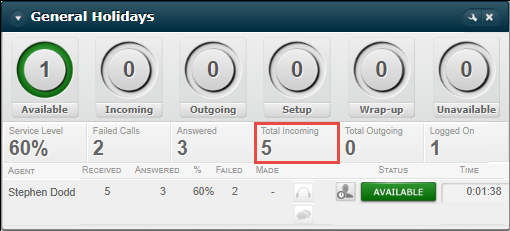FAQ 1: Real-Time Versus Historical Statistics
Question
Why is my real-time Agent Group module showing more incoming calls than I see in my historical report?
Answer
The Total Incoming statistic in the Agent Group Module is the total number of contacts routed to agents in the group irrespective of whether or not the routed communication attempts were answered (connected to agents).

The discrepancy usually arises if your historical report is using the CONTACT Data Records data source. In this data source, there is an inbound communication leg for every interaction and one or more outbound legs depending on the progression of the interaction. Multiple outbound legs result if, for example, there are multiple attempts to route interactions to agents or if an interaction is transferred to other agents.
A metric that counts outbound legs (that is, interactions routed to agents) will give a similar value to that shown in the real-time Agent Groups module. A metric that counts inbound legs (that is, the number of callers), will give a lower value.
In the library of VIEW standard historical metrics, the Incoming Communication Attempts metric returns the same result as the Total Incoming statistic in the Agent Group module. This metric is also available in the standard historical report Agent Groups delivered with VIEW.
Another point to consider is historical reports where metrics are broken down on the Agent Group dimension (such as in the standard Agent Groups report) and where one or more of the agent groups have sub-groups. In such a report, an agent group's statistics do not increment for interactions to any of that agent group's subgroups. In the real-time Agent Group module, however, these statistics are included in the parent agent groups. See also, Agent Subgroup Statistics.